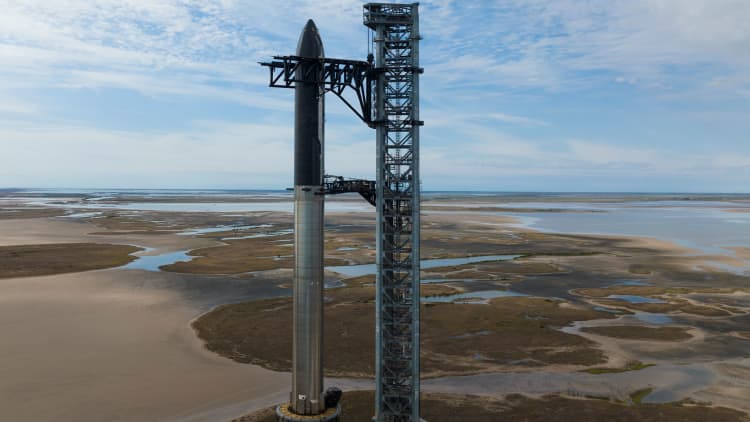View of Space X's Starship on the launch pad for its seventh test flight, in Boca Chica, Texas, U.S.
Maxar Technologies | Via Reuters
SpaceX launched the seventh test flight of its Starship rocket on Thursday, but lost communication with the upper stage of the rocket that continues on into space.
The company's webcast showed data stopped transmitting from Starship about nine minutes into the launch.
"We can confirm that we did lose the ship," SpaceX senior manager of quality systems engineering Kate Tice said.
SpaceX said in a post on X that the ship broke up during its ascent burn and that it would "continue to review data from today's flight test to better understand root cause."
After the rocket lost communication, social media users posted photos and videos of what appeared to be fireballs in the sky near the Caribbean islands. Starship's launch trajectory takes it due east from Texas, which means the fireballs are likely debris from the rocket breaking apart and reentering the atmosphere.
JetBlue Flight 353 from Fort Lauderdale, Florida, that showed as headed for San Juan, Puerto Rico, on the airline's website, had made a sharp turn west north of Turks and Caicos, almost two hours into the flight and appeared to be returning to Fort Lauderdale, according to flight-tracking site FlightAware. Spirit Flight 172 from Chicago O'Hare Airport to San Juan also appeared to be turning around in the area. Other flights, including a cargo plane from FedEx also appeared to be turning around.
The airlines and the FAA did not immediately respond to CNBC's request for comment. As is required for rocket launches, standard air traffic control advisories were in place.
SpaceX's mega rocket Starship booster returns to the launch pad during a test flight from Starbase in Boca Chica, Texas, Thursday, Jan. 16, 2025.
Eric Gay | AP
Starship launched from SpaceX's private "Starbase" facility near Brownsville, Texas, shortly after 5:30 p.m. ET. A few minutes later, the rocket's "Super Heavy" booster returned to land at the launch site, in SpaceX's second successful "catch" during a flight. It did not catch the booster on the last flight.
There were no people on board the Starship flight. However, Elon Musk's company was flying 10 "Starlink simulators" in the rocket's payload bay and planned to attempt to deploy the satellite-like objects once in space. This would have been a key test of the rocket's capabilities, as SpaceX needs Starship to deploy its much larger and heavier upcoming generation of Starlink satellites.
While SpaceX didn't specify what the Starlink simulators were made of, mass simulators are commonly used in rocket vehicle development and are often simple constructions of metal or concrete that weigh roughly the same as the object in question.
Read more CNBC space news
Before losing communication, Starship was set to reach space and then travel halfway around the Earth before reentering the atmosphere and splashing down in the Indian Ocean about an hour after liftoff.
As with each previous flight, SpaceX aims to push development further by assessing additional Starship capabilities, including tests of its heatshield tiles and the trajectory of its intense reentry.
SpaceX's mega rocket Starship launches for a test flight from Starbase in Boca Chica, Texas, Thursday, Jan. 16, 2025.
Eric Gay | AP
Starship is critical to the company's plans, even with its $350 billion valuation and already dominant position in the space industry.
Starship is both the tallest and most powerful rocket ever launched. Fully stacked on the Super Heavy booster, Starship stands 403 feet tall and is about 30 feet in diameter. SpaceX has flown the full Starship rocket system on six spaceflight tests so far since April 2023, at a steadily increasing cadence.
The Super Heavy booster, which stands 232 feet tall, is what begins the rocket's journey to space. At its base are 33 Raptor engines, which together produce 16.7 million pounds of thrust — about double the 8.8 million pounds of thrust of NASA's Space Launch System rocket, which launched for the first time in 2022.
Starship itself, at 171 feet tall, has six Raptor engines — three for use while in the Earth's atmosphere and three for operating in the vacuum of space.
The rocket is powered by liquid oxygen and liquid methane. The full system requires more than 10 million pounds of propellant for launch.
SpaceX's mega rocket Starship and booster separate during a test flight from Starbase in Boca Chica, Texas, Thursday, Jan. 16, 2025.
Eric Gay | AP
The Starship flying on this launch, tagged as Ship 33, also represents a second-generation version of the vehicle, called "Block 2."
SpaceX noted that the "significant upgrades" to this vehicle include changes to the flaps on the vehicle's nose, redesigns of its propulsion system to boost performance, an enhanced flight computer, 30 cameras placed along the vehicle for monitoring the rocket and a reinforced heat shield.
Additionally, the booster for this flight attempt features a reused Raptor engine. That engine flew during the fifth test flight last year.
The Starship system is designed to be fully reusable and aims to become a new method of flying cargo and people beyond Earth. The rocket is also critical to NASA's plan to return astronauts to the moon. SpaceX won a multibillion-dollar contract from the agency to use Starship as a crewed lunar lander as part of NASA's Artemis moon program..

— CNBC's Leslie Josephs contributed to this report.

 1 day ago
1 day ago














